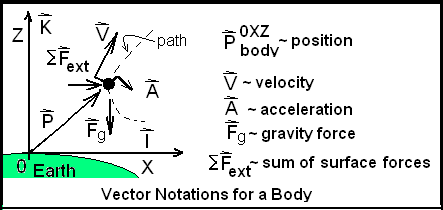| THERMO Spoken Here! ~ J. Pohl © ( A4339~3/15) | ( A4340 - 1.17 Vector Notations) |
1.16 Vectors: BODY
Typical vectors for a BODY (as system) are its spatial properties: position and velocity (also acceleration). The gravity force and sum of surface (or external) forces, ΣF, are vectors. The figure shows a BODY in 0XZ-space with a notation for its vectors.

Details of the figure are:
- An origin is selected at rest on Earth. The position vector is referenced to the origin.
- The tails of the velocity and acceleration vectors are slightly offset from the BODY to distinguish these vectors from forces.
- The velocity is always tangent to the path of motion of the BODY.
- Were gravity is inconsequential (the coordinates 0XY are used rather than 0XZ), the direction of the acceleration vector is the same as the direction of the sum of forces.
- Minor point: Either the "head" or the "tail" of a force vector might be applied at the BODY. When the "head" of the vector touches the BODY, a "push" is implied. For a "pull" the tail of the vector contacts the BODY.
Beginners might think there is too much notation. Sketches that retain the physicality of physical situations require careful, consistent graphical notation. Notations are learned not so much for simple problems; they are learned as preparation to understand and solve more difficult problems.
1.16 Vectors: BODY

Typical vectors for a BODY (as system) are its spatial properties: position and velocity (also acceleration). The gravity force and sum of surface (or external) forces, ΣF, are vectors. The figure shows a BODY in 0XZ-space with a notation for its vectors.
Premise presently unwritted!